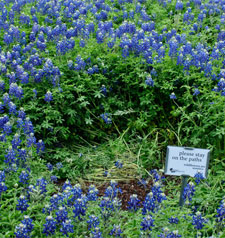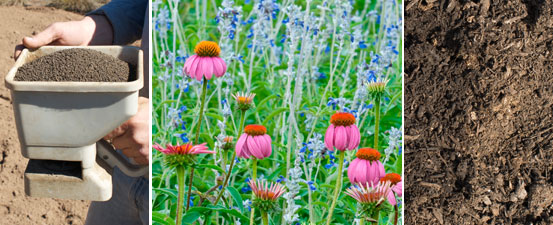Want to wreck your wildflowers?
DOESN’T IT SEEM LIKE THE WILDFLOWERS that we plant in our gardens should be indestructible? After all, they seem to grow so effortlessly in nature.
Things may not be what they seem from your car window, according to Mark Simmons, Ph.D., Wildflower Center ecologist and director of its Ecosystem Design Group. “It literally took millions of seeds and decades to arrive at the right conditions to paint that picture you see,” says Simmons. “It didn’t take just a season or two and a few plugs to create the wildflower meadows that you see in nature.”
Simmons and other Center staff often encounter visitors who wonder what went wrong in their gardens when wildflowers wither. We decided to poll our experts about the top 10 ways to ruin your wildflowers. Read on to see what not to do if you want your wildflowers to look like the ones that you see in nature.
Top 10 Ways to Ruin Your Wildflowers
1) Don’t mind your water. Our experts agree that giving your plants too much or too little water is the best way to destroy them. Director of Horticulture Andrea DeLong-Amaya recommends watering lightly for the first couple of weeks after seeding wildflowers if no rain has fallen, then tapering off frequency and increasing amounts as the plants establish their roots. Always check the soil moisture before watering since wilt doesn’t always mean that a plant is dry.
2) Ignore the soil. John Hart Asher, MLA, of the Wildflower Center’s Ecosystem Design Group, says studies have shown that plants will grow at least three times better and faster in soil enriched with compost than in bare soil. Many gardeners overlook this step before they plant. You want to look for compost that is low in nitrogen and phosphorous since many native species are adapted to low nutrient conditions.
3) Pairing plants that don’t get along. Mixing the wrong type or incompatible species is a no-no, say our experts. “People like to pair bluebonnets and other wildflowers or grasses in the same place and are surprised when neither survives,” says Simmons. “Bluebonnets like the space to themselves — they don’t like competition for light, water or soil nutrients — if you don’t weed your bluebonnet patch you will have less of a display.”

Tread softly through bluebonnets.
4) Tiptoeing through the bluebonnets. While it’s hard not to want to romp around in the wildflowers, we don’t have to explain why this could backfire. This includes stomping along the roadsides to take baby pictures.
5) Ignore the wildflower area outside of wildflower season. Many wildflowers are what ecologists call “early successional” — which means that they bloom best after a disturbance such as fire or heavy grazing. Eventually other “late successional” species take over and dominate until the next disturbance. So you may want to tend your wildflower area throughout the year — mowing is one standard way to maintain a wildflower meadow by keeping the grasses at bay.
6) Using fertilizer. “Just don’t do it,” says Andrea DeLong-Amaya. “Ordinarily, we don’t consider it necessary to do much fertilizing of plants native to a particular area, because they are already accustomed to growing in the climate and soil.” Same goes for insecticides and fungicides (or more generally pesticides), which should only be used as a last resort. Since they are better adapted to the conditions of a site, native plants are generally more pest-resistant than non-natives anyway.
7) Poor mowing regimen. In general, once your meadow wildflowers have bloomed you should wait to mow them until at least half of the late-blooming species have dropped seeds.

LEFT TO RIGHT Take care of your garden’s soil by adding compost prior to planting or seeding. Purple coneflower and mealy blue sage in Austin. Make sure not to use too much mulch in your wildflower patch or they will not reseed.
8) Burying your wildflower patch in mulch. This may seem obvious, but gardeners make this mistake nonetheless. “Most seeds will germinate through a light layer of mulch,” says DeLong-Amaya. “But we generally don’t recommend mulching areas where you want your wildflowers to reseed.”
9) Ignoring place and time. Putting plants in a spot that is too sunny or shady for the species or seeding outside of recommended seeding times are common mistakes.” says Simmons.
10) Choosing plants designed to kill. Allelopathic plants release chemicals that thwart the growth and development of nearby plants. The winter rye that homeowners in Central Texas like to plant as lawn also is a preferred cover crop for its ability to crowd out undesired plants. Be careful not to plant allopathic plants near your wildflower patch because they could have the same unintended effect

